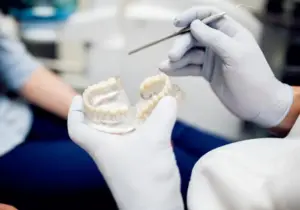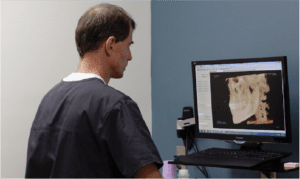For adults, surgical intervention for replacing teeth with dental implants is completely safe and highly effective at restoring the look and function of your teeth. The added bonus is that, even more than not affecting the other teeth around the implant, it actually stabilizes the other teeth, your jaw, and your bite.
Dental implants are installed into the jaw bone, replacing the root of the missing tooth, and is then crowned with an entire fake tooth that looks and feels natural. And, most of the time, dental implants last a lifetime. It’s great if you’re all grown up; but how does dental implant surgery work on a child? Or does it at all?
So, your kid comes back from riding his bike and roughhousing with his friends and shows you a space where a tooth used to be. It happens. Unfortunately, it’s an adult tooth he lost, so there’s not another one coming in to replace the tooth that got knocked out – they’re out of luck. There are several options for replacing teeth knocked out by facial trauma, dental implants being the gold standard in the field of oral surgery.
But is dental implant surgery safe to perform on kids?
Reasons Why Dental Implants Aren’t an Option for Children
Pediatric dentistry and oral surgery is different than oral medicine for adults. Why? Adults are fully-grown; not a lot is changing there with regard to jaw position and mouth structure. Kids’ jaws, on the other hand, are always changing; your bones don’t stop growing until late adolescence – usually until the age of 15 to 18.
This presents different challenges for oral surgeons who replace kids’ missing teeth – challenges that require different strategies. An oral surgeon working on a child’s teeth wants to choose the least inconvenient and healthiest choice to reconstruct their smile, but they’re not dealing with the same environment as in an adult’s mouth.
A few reasons kids under the age of 16 or so can’t get dental implants are:
- A permanent installation like a dental implant can interfere with other teeth erupting properly.
- As the child’s jaw continues developing, the implant can move out of place.
- The implant’s crown and root can shift other teeth around, increasing the chance of needing orthodontic intervention.
- In rare cases where a surgeon does perform dental implant surgery on a child who has suffered facial trauma, the dental implant will likely need to be replaced a few times as the child grows.
Don’t worry – your kid’s not out of luck with that knocked-out tooth. There are several effective stop-gap options for replacing the tooth temporarily, until they’re grown enough for a prosthetic implant:
- Removable partial dentures
- Dental bridges
- Flippers
- Space maintainers for lost milk teeth
- Porcelain crowns attached to braces, for those who were going to get braces anyway
So if you’re kid’s lost an adult tooth, rest assured that just because they can’t get a permanent method of reconstruction now, your oral surgeon will set them on the best path for getting one in the future; it just takes a little patience.









